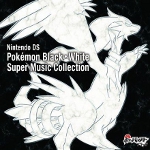Pokémon DS -Black & White- Super Music Collection
 |
Album Title: Pokémon DS -Black & White- Super Music Collection |
| Record Label: Media Factory |
|
| Catalog No.: ZMCP-5919 |
|
| Release Date: October 20, 2010 |
|
| Purchase: Buy at CDJapan |
Overview
Released in late 2010, the newest entry in the Pokémon franchise, Pokémon Black and Pokémon White has received accolades in Japan for some major overhaul to quite a number of franchise mainstays, delivering an entirely new yet familiar experience. The soundtrack, Pokémon Black & White Super Music Collection, as well, is an entirely different beast from its predecessors, featuring higher quality synth and looped tracks. Are the compositions themselves, however, worth hearing?
Body
The soundtrack starts proper with “Title,” which quickly delves into an arranged version of the main Pokémon theme. This introduction is bombastic but not altogether unpleasant, and serves as a decent opener for what’s to come. “Route 1,” being the first area theme in the game, is sanguine and vivacious, though otherwise not terribly noteworthy. “Route 10,” however, with its mellow Parisian influence, is easily the most enjoyable piece of its moniker on the album.
Among the village themes, “Kanoko Town,” curiously enough, is reminiscent of Tenpei Sato’s “Orange Village”, with its reliance on harmonica providing a backdrop for a yearning, western-sounding melody. It’s a peaceful song, and well suited for the game’s first village. “Sanyou Village,” meanwhile, is much lighter, thanks to its curious accordion and brass ensemble which balances the melody’s evolution quite well. The listener really feels the nightlife with “Shippou City,” a pleasant and soothing jazz piece, while “Raimon City” is another jazzy track featuring far more aggressive orchestration. However, not even this track aforementioned can compare to the blazing trumpets of “Fukiyose City” or its rather addictive electronic sections that give the track a flavor of its own. “Sekka City” has an endearing folksy charm to it, though the percussion sounds a bit too heavy.
Some setting themes are presented in a series of variations. It was wise to disperse all four variations of “Route 4,” as they are all rather similar to one another. Its melody, regardless, is somewhat catchy, and its adventurous tones are infectious. “Souryuu City (Black)” might be the more interesting of its two variations, but it ends up a bit too busy compared to the soothing tones of “Soryuu City (White).” Similarly, the peaceful and minimalist “Sanazami Town (Autumn~Spring)” uses calming sounds of the ocean far better than its crass variant, “Sanazami Town (Summer).” These variations all bring interactivity and novelty to the gameplay. Their effect is reduced on a stand-alone basis, but they’re not overly repetitive in part due to the expansive nature of the soundtrack release.
Though there is a fair amount of filler on this release, several themes are particular highlights for me. “N’s Castle” is a rather superbly crafted though melodically simplistic little gothic piece. It also features undertones of Tenpei Sato, thanks to its shifting choir work. “The Pleasure Cruise Ship, The Royal Isshu” is quite a soothing, well orchestrated piece, likely the most emotional on the album at its melodic climax. Meanwhile, a great contrast is provided by “Gear Station,” a coarse, yet intelligent, jazzy piece. “Village Bridge” is worth a mention, if only for the odd synthetic vocals that pervade the piece, though taken with a grain of salt, the track isn’t bad at all.
The battle themes all tend to be standard Pokémon affair. They are driving, brass heavy tunes that evolve well but tend to lack a cohesive, catchy melody, instead flitting from one idea to the next. Some notable themes include the synth-heavy, gothic “Decisive Battle! N,” the minimalist, percussive “Battle! Geechisu,” and “Battle! Legendary Pokémon,” which features some neat synth percussion. Each of these tracks represents the encounters in a novel and fitting way.
The final disc of the soundtrack is rather short and dominated by a number of filler tracks. However, the album impressively concludes with four arrange tracks. “Summer in Kagome” is a simple piece, though it still is quite enjoyable, featuring a cheery melody on the flute with some soft percussion. Overall, it transmits the feeling of summer quite well. “Lullaby for Trains” is a soft jazz piece with a curious little ragtime section inserted halfway through, while “sayonara –refrain-” is a peaceful track that develops quite well. “LAST BATTLE -N^n mix-” is a neat little mix of one of the game’s more creative battle tracks. Heavy synth and electric guitar use pervades this track, creating a grungy sort of feel that meshes well with the simplistic melody.
Summary
The Pokémon Black & White Super Music Collection is the most accomplished Pokémon score to date, featuring quite respectable synth quality, and, perhaps more importantly, some much needed variation amongst most of the tracks. That said, there’s still an overabundance of filler material, and not terribly many tracks really do stand out on the stand-alone release. However, the soundtrack is certainly impressive in context with its great variety and detail. Though certainly not a necessity for a game music collector, the soundtrack remains an interesting and enjoyable listen.
Do you agree with the review and score? Let us know in the comments below!
4
Posted on August 1, 2012 by Marc Friedman. Last modified on January 16, 2016.














